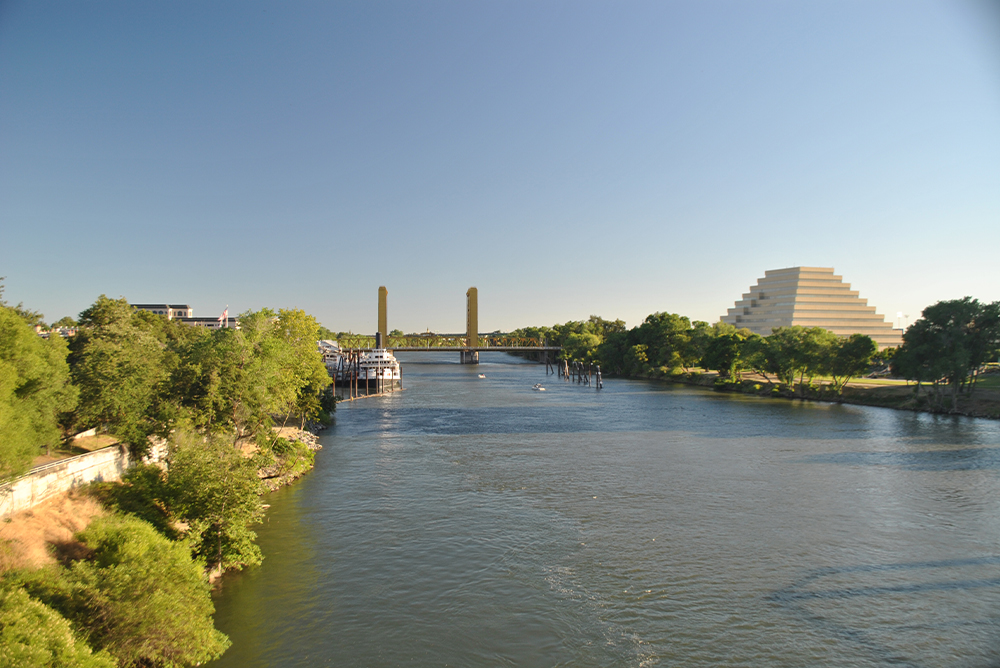
The Oakland A’s have temporarily moved in at West Sacramento’s minor league ballpark—which should bring the small city some more well-earned attention, writes columnist Joe Mathews. Photo of the Sacramento River, which divides West Sacramento, on the right, from California’s capital city. Courtesy of Wayne Hsieh/Flickr (CC BY-NC-SA 2.0 DEED).
The Oakland A’s are baseball’s biggest losers. But their new temporary home—West Sacramento—is one of California’s greatest winners.
No California city has had a better 21st century than West Sacramento. The municipality of 54,000 people has grown in population and prosperity with striking speed, even as California has stagnated on both fronts.
The A’s will spend three years, 2025 through 2027, in West Sacramento’s minor league ballpark as the team waits for a new stadium to be built in their future home, Las Vegas. Perhaps their relocation will bring West Sac, as it’s often called, more of the notice it merits, both in California’s city halls and among state policymakers.
The city’s success is attributable to smart local governance, and to three paradoxes best explained in light of California peculiarities.
The first paradox: West Sac was able to grow rich because it was so poor. Across the river, Sacramento became a city in 1849, a year before California won statehood. West Sacramento didn’t incorporate until 1987. For most of the 20th century, it was an afterthought—an industrial town of seedy hotels, vacant lots, warehouses, rice silos, and major highways nearby communities didn’t want.
All that kept land prices low, which made West Sac attractive as the rest of the region became more expensive. The city carefully invested in new infrastructure, streets, and sewers to allow for new neighborhoods. A first wave of development, around the turn of the century, focused on the riverfront. Among the catalysts there was the A’s future digs, previously called Raley Field (now named for Sutter Health), which opened in 2000.
This brings me to the second paradox: West Sac achieved big success because it was small. A quarter century ago, it had just 30,000 residents and a median household income of $32,000. Residents wanted to see improvements. And the powerful unions, environmental groups, and state agencies that so often delay California projects were too busy elsewhere to mess with a poor city with relatively few people.
So, Raley Field took just 19 months from ground-breaking to opening. Restaurants and other businesses found they could launch quickly. And while housing construction languished elsewhere, West Sacramento built both market and affordable housing at some of the fastest rates in California. That speed was a function of West Sac’s ability to create entire new neighborhoods, like master-planned Southport, as well as infill development in the city center.
The small city also faced little public opposition as it used its cheap land to bring in several large retailers, most notably the Capitol region’s first IKEA, a crowning achievement, in 2006. The retailers produced considerable sales taxes that provided the city with revenues for more projects. After the retailers came corporate headquarters, many of them companies involved in food production.
Such speedy development points to the third paradox: West Sac benefited both because of its distance from, and its proximity to, the city of Sacramento.
The two cities lie just across the river from each other. But West Sac is its own separate municipality and is situated in a different county, Yolo, with a mix of rural places and smaller cities. Sacramento runs on constant political competition, which can distract from the slow and painstaking work of governance. West Sac has had the good fortune of stable political leadership for over a generation.
The embodiment of that stability was Christopher Cabaldon, a legislative aide and higher education administrator who first moved to West Sac after taking the wrong freeway off-ramp. He ended up serving on the city council and then as mayor for more than two decades.
In a small community, he could move fast. “We focus on results as opposed to process,” he told Governing in 2019. “A lot of other communities are into community meetings and workshops and planning and task forces and consultant reports, and, no, that’s not us.”
In contrast to Sacramento, whose city government is prone to obsess about creating signature attractions (an arena, an aquarium), to draw visitors, West Sac focused on building the housing and amenities to attract more residents.
Its proximity to the Capitol eventually became a draw. As California’s growing state government brought more people to Sacramento, and affordable housing became ever harder to find, people took notice of West Sac, with its new housing, new neighborhoods, and new restaurants. Many West Sac residents lived so close to the Capitol that they could walk across the Tower Bridge and be at work in minutes.
In 2014, West Sac was named the “Most Livable City in America” by the U.S. Conference of Mayors. The honor only made West Sac more ambitious. In 2017, with more families moving in, the city devoted its growing revenues to West Sacramento Home Run, an initiative offering universal preschool and college saving accounts. Its household median income now exceeds $87,000.
Ironically, the very same state government whose proximity helped West Sac grow also produces regulations that make it harder for California cities to grow. Now that West Sac is bigger, its leaders confront more obstacles and opposition. But West Sac remains a great counter-example of what California cities might do if they had more freedom.
The A’s decision to come to town brought public joy. Many Capitol region residents say that they can’t wait to go to the West Sac ballpark and marvel at the famous stars of the Dodgers and Yankees as they hit homers against the weak, and temporary, home team.
Of course, the real marvel won’t be the ballplayers, but the small city they’ll be visiting.




Send A Letter To the Editors